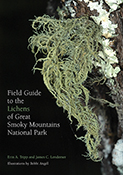Field Guide to the Lichens of Great Smoky Mountains National Park

With 909 recognized species of lichens, Great Smoky Mountains National Park (GSMNP) is home to more of these lichenized fungi than any other national park in the United States, as well as nearly half of all species known to occur in eastern North America. There is a great deal of room for scientific exploration, inquiry, and systematic description in the realm of lichenology. In Field Guide to the Lichens of Great Smoky Mountains National Park, Erin Tripp and James Lendemer take on the formidable task of creating an all-in-one resource for Park exploration, including lichen distribution maps, tools for identification, vivid photographs and illustrations, and even field notes from their own research campaigns. In the process, the authors create a touchstone for lichen taxonomy and ecology, and they inspire others—researchers as well as casual observers—to take interest in the incredible biodiversity of the Great Smoky Mountains. Biologists, botanists, visitors to the park, naturalists, and others interested in the flora and fauna of both the southern Appalachians and GSMNP will thoroughly enjoy this lovingly prepared field guide.
ERIN A. TRIPP is an assistant professor of ecology and evolutionary biology as well as curator of botany at the University of Colorado. Her works include Field Guide to the Lichens of White Rocks and publications in prestigious scientific journals, such as Trends in Ecology & Evolution, Journal of Biogeography, Systematic Botany, and Moleculer Ecology.
JAMES C. LENDEMER is an assistant curator at the Institute of Systematic Botany, New York Garden. His works include Delmarva Lichens, An Illustrated Guide and publications in prestigious scientific journals, such as BioScience, Biodiversity & Conservation, The Bryologist, Mycologia, and the Journal of the Torrey Botanical Society.
